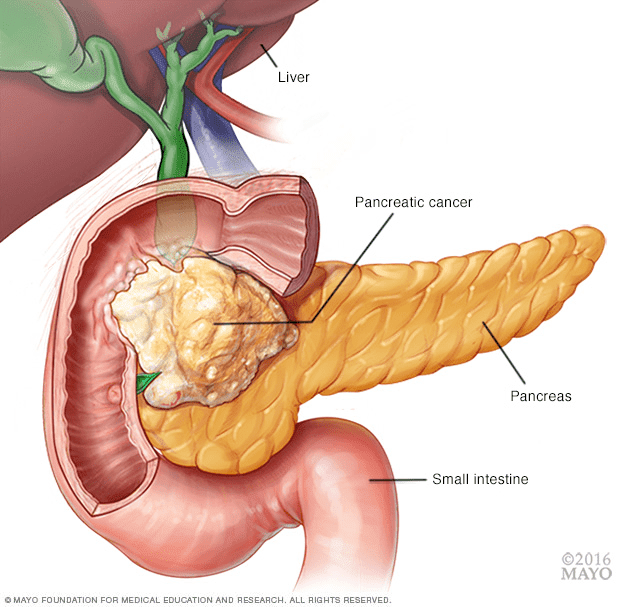Pancreatic Cancer Stage Four
Pancreatic cancer stage four - Pancreatic cancer is cancer of the pancreas. The pancreas is a large organ located behind the stomach horizontally. The pancreas secretes digestive juices and hormones that regulate the metabolism of sugars. When the pancreas cells develop genetic mutations that lead to uncontrolled cell growth. These cells continue to live, even after normal cells die and these cells accumulate to form a tumor. Rare pancreatic cancer when caught at an early stage. The symptoms do not seem until the cancer is at an advanced stage. Many doctors have difficulty in detecting cancer in the first stage to contain its spread. Pancreatic cancer stage four is the most dangerous stage, which can even lead to death.
Pancreatic cancer stage four (IV): Overview
The fourth most common cause of death was pancreatic cancer. This type of cancer is known prognosis. The chance of survival is 25% for 1 year and only 6% for 5 years in the case of metastatic cancer. Localized cancer has a survival probability of more than about 20% for 5 years. In pancreatic cancer stage four (IV), the cancer or the tumor is no longer localized and moved to other parts, such as the stomach, spleen, and intestines. It can also pass on organs such as the lungs and liver. Pancreatic cancer stage four (IV) is divided into two groups:
Pancreatic cancer stage IVA :
Limited to a local level, involving adjacent organs and blood vessels. This causes problems in the surgical removal of the tumor. Pancreatic cancer stage IVA is known as a localized or locally advanced stage.
Pancreatic cancer stage IVB :
Cancer spreads to distant organs. This stage is also known as the metastatic stage.
The symptoms of pancreatic cancer
As mentioned earlier, the symptoms appear when the disease is at an advanced stage. Therefore, it is known as a "silent killer" if the symptoms are varied and non-specific exposed character. These symptoms include:
Risk factors that increase the chances of developing pancreatic cancer are:
Your doctor can strongly recommend the following tests if suspected of pancreatic cancer:
Ultrasound :
high-frequency sound waves to create images of the pancreas helps. This allows you to determine whether an obstruction in the bile ducts and the area of the obstruction is identified.
TAC :
This test is recommended for people who have sudden, unexplained weight loss and abdominal pain. TAC, biliary obstruction or pancreatic cable ducts or evidence of cancer spread outside the pancreas.
Biopsy :
A small sample of the pancreas is obtained and examined under a microscope to ensure pancreatic cancer.
Liver Function Testing :
This test is used to identify a combination of results indicating a bile duct obstruction.
Pancreatic cancer stage four (IV): Overview
The fourth most common cause of death was pancreatic cancer. This type of cancer is known prognosis. The chance of survival is 25% for 1 year and only 6% for 5 years in the case of metastatic cancer. Localized cancer has a survival probability of more than about 20% for 5 years. In pancreatic cancer stage four (IV), the cancer or the tumor is no longer localized and moved to other parts, such as the stomach, spleen, and intestines. It can also pass on organs such as the lungs and liver. Pancreatic cancer stage four (IV) is divided into two groups:
Pancreatic cancer stage IVA :
Limited to a local level, involving adjacent organs and blood vessels. This causes problems in the surgical removal of the tumor. Pancreatic cancer stage IVA is known as a localized or locally advanced stage.
Pancreatic cancer stage IVB :
Cancer spreads to distant organs. This stage is also known as the metastatic stage.
The symptoms of pancreatic cancer
As mentioned earlier, the symptoms appear when the disease is at an advanced stage. Therefore, it is known as a "silent killer" if the symptoms are varied and non-specific exposed character. These symptoms include:
- Pain in the upper abdomen that can be felt in the back.
- Jaundice
- Stomach sign (spontaneous formation of blood clots in the body)
- Weight loss
- Nausea
- Loss of appetite
- General weakness
- Fatigue
- Depression
- Inflamed gallbladder
- Diabetes
Risk factors that increase the chances of developing pancreatic cancer are:
- Smoke
- Obesity
- A family history of chronic pancreatitis.
- Heritage
- Old age, such as the elderly 60-70 years are more prone to pancreatic cancer
- Chronic pancreatitis
- Diets with lots of sugary drinks and red meat
- Diets that are low in fruits and vegetables are
Your doctor can strongly recommend the following tests if suspected of pancreatic cancer:
Ultrasound :
high-frequency sound waves to create images of the pancreas helps. This allows you to determine whether an obstruction in the bile ducts and the area of the obstruction is identified.
TAC :
This test is recommended for people who have sudden, unexplained weight loss and abdominal pain. TAC, biliary obstruction or pancreatic cable ducts or evidence of cancer spread outside the pancreas.
Biopsy :
A small sample of the pancreas is obtained and examined under a microscope to ensure pancreatic cancer.
Liver Function Testing :
This test is used to identify a combination of results indicating a bile duct obstruction.
*Image source : Mayo Clinic
References :

Post a Comment for "Pancreatic Cancer Stage Four"